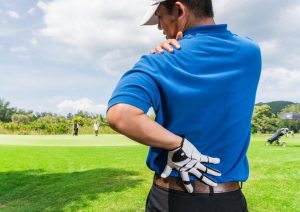 By: USGTF Technical Committee
Injuries are a part of golf, just like in any other sport. It seems, though, that more top professionals are being sidelined with injuries, perhaps none more so than Tiger Woods. Jason Day also has had numerous ailments that have kept him from competing.
Among the older crowd, Fred Couples has fought a balky back for his entire career, and Bill Glasson had numerous surgeries in his playing heyday. But these seem to be the exception rather than the rule. It may just be that with today’s ever-present media, golf injuries in the professional ranks are more noted than they were in the past.
Chris Finn, owner of Par4Success, notes that in golf, pain that can be felt in one part of the body is often the result of a true injury in another part of the body. He says that is important for golfers to not only be flexible, but strong enough to handle the clubhead speeds that they are generating. So, the first order of defense in preventing injuries is to properly train the body. Although many people do not have access to personal trainers for golf, or the cost may be prohibitive, there are many good resources online, including YouTube, that have accurate and up-to-date information. Another line of defense in preventing injuries is to have proper swing mechanics. Those who tend to have a reverse pivot or reverse tilt golf swing often create torques on the back greater than what the back was meant to handle.
Stretching is also a key element in preventing injuries. There are now stretching professionals that can be found at places such as The Stretch Zone, where these professionals can provide assisted stretching beneficial to all golfers. Chiropractic care is another avenue worth exploring.
However, injuries can occur despite our best efforts at prevention. It is critical to follow any rehabilitation program given to us, and as the old saying goes, “No one ever said they came back too late from an injury.” In other words, don’t rush it. Those who are overcoming injuries should not play or practice until their medical professional has given them permission to do so. And once permission is granted, it is important to not overwork. By following the professionals’ advice and counsel, any injured golfer will be back on the course before they know it.
By: USGTF Technical Committee
Injuries are a part of golf, just like in any other sport. It seems, though, that more top professionals are being sidelined with injuries, perhaps none more so than Tiger Woods. Jason Day also has had numerous ailments that have kept him from competing.
Among the older crowd, Fred Couples has fought a balky back for his entire career, and Bill Glasson had numerous surgeries in his playing heyday. But these seem to be the exception rather than the rule. It may just be that with today’s ever-present media, golf injuries in the professional ranks are more noted than they were in the past.
Chris Finn, owner of Par4Success, notes that in golf, pain that can be felt in one part of the body is often the result of a true injury in another part of the body. He says that is important for golfers to not only be flexible, but strong enough to handle the clubhead speeds that they are generating. So, the first order of defense in preventing injuries is to properly train the body. Although many people do not have access to personal trainers for golf, or the cost may be prohibitive, there are many good resources online, including YouTube, that have accurate and up-to-date information. Another line of defense in preventing injuries is to have proper swing mechanics. Those who tend to have a reverse pivot or reverse tilt golf swing often create torques on the back greater than what the back was meant to handle.
Stretching is also a key element in preventing injuries. There are now stretching professionals that can be found at places such as The Stretch Zone, where these professionals can provide assisted stretching beneficial to all golfers. Chiropractic care is another avenue worth exploring.
However, injuries can occur despite our best efforts at prevention. It is critical to follow any rehabilitation program given to us, and as the old saying goes, “No one ever said they came back too late from an injury.” In other words, don’t rush it. Those who are overcoming injuries should not play or practice until their medical professional has given them permission to do so. And once permission is granted, it is important to not overwork. By following the professionals’ advice and counsel, any injured golfer will be back on the course before they know it.
Copyright © 2023 United States Golf Teachers Federation, All Rights Reserved
200 S. Indian River Drive, Suite #206, Fort Pierce, FL 34950
772-88-USGTF or 772-595-6490 - www.usgtf.com
200 S. Indian River Drive, Suite #206, Fort Pierce, FL 34950
772-88-USGTF or 772-595-6490 - www.usgtf.com
